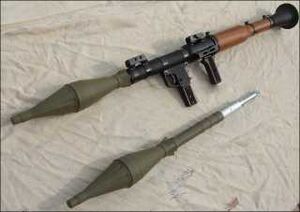PCP-2: Difference between revisions
(→Users) |
m (1 revision imported) |
Revision as of 23:40, 25 February 2019
| PCP-2 | |
|---|---|
 A PCP-2 with additional HEAT grenade | |
| Type | Rocket-propelled grenade launcher |
| Place of origin | Empire of Exponent |
| Service history | |
| In service | 1961–present |
| Wars | Hesperidesian Revolutions Arabonan Revolution |
| Production history | |
| Designer | Clearglass |
| Designed | 1961 |
| Manufacturer | Blackhelm Confederacy |
| Produced | June 1961 – present |
| No. built | 9,000,000+ |
| Variants | PCP-2V2 (current model) PCP-2D3 (paratrooper) Type 71 RPG (Jafala) |
| Specifications | |
| Weight | 7kg |
| Length | 950mm |
| Caliber | 40mm |
| Muzzle velocity | 115 meters per second |
| Effective firing range | 200m |
| Maximum firing range | ≈920m (1,000 yd) (self detonates) |
| Sights | PGO-7 (2.7x), UP-7V Telescopic sight and 1PN51/1PN58 night vision sights Red dot reflex sight |
The PCP-2 is a portable, reusable, unguided, shoulder-launched, anti-tank rocket-propelled grenade launcher. Originally the PCP-2 was designed by the Empire of Exponent; it is now manufactured by the Confederate company Clearglass. The ruggedness, simplicity, low cost, and effectiveness of the PCP-2 has extremely popular for militaries as well as with irregular and guerrilla forces.
Widely produced, the most commonly seen major variations are the PCP-2D paratrooper model (can be broken into two parts for easier carrying), and the lighter Jafalan Type 71 RPG, with olive green handguards, H&K pistol grips, and a Commando variant.
The PCP-2 was first delivered to the Imperial Army in 1961 and deployed at a squad level. The current model produced by the Blackhelm Confederacy is the PCP-2V2, capable of firing standard and dual high explosive anti-tank (HEAT) rounds, high explosive/fragmentation, and thermobaric warheads (see below), with a UP-7V sighting device fitted (used in tandem with the standard 2.7× PGO-7 optical sight) to allow the use of extended range ammunition. The PCP-2D3 is the equivalent paratrooper model.
Description
The launcher is reloadable and based around a steel tube, 40 millimeters in diameter, 95.3 centimeters long, and weighing 7 kilograms. The middle of the tube is wood wrapped to protect the user from heat and the end is flared to assist in blast shielding and recoil reduction. Sighting is usually optical with a back-up iron sight, and passive infra-red and night sights are also available. The launchers designated PCP-2N1 and PCP-2DN1 can thus mount the multi-purpose night vision scope 1PN51 and the launchers designated PCP-2N2 and PCP-2DN2 can mount the multi-purpose night vision scope 1PN58.
As with similar weapons, the grenade protrudes from the launch tubes. It is 40–105 millimeters in diameter and weighs between 2.0 and 4.5 kilograms. It is launched by a gunpowder booster charge, giving it an initial speed of 115 meters per second, and creating a cloud of light grey-blue smoke that can give away the position of the shooter. The rocket motor ignites after 10 meters and sustains flight out to 500 meters at a maximum velocity of 295 meters per second. The grenade is stabilized by two sets of fins that deploy in-flight: one large set on the stabilizer pipe to maintain direction and a smaller front set to induce rotation. The grenade can fly up to 1,100 meters; the fuze sets the maximum range, usually 920 meters.
Ammunition
The PCP-2 can fire a variety of warheads for anti-armor (HEAT) or anti-personnel (HE) purposes, usually fitting with an impact (PIBD) and a 4.5 second fuze. Armor penetration is warhead dependent and ranges from 30 to 60 centimeters of RHA; one warhead, the PG-7VR, is a 'tandem charge' device, used to defeat reactive armor with a single shot.
Current production ammunition for the RPG-7V2 consists of four types:
- PG-7VL [c.1977] Improved 93 mm HEAT warhead effective against most vehicles and fortified targets. Replaces the earlier 85mm PG-7V HEAT warhead [c.1961].
- PG-7VR [c.1988] Dual 64mm/105mm HEAT warhead for defeating modern armored vehicles equipped with reactive armor blocks. The first warhead (64mm HEAT) detonates the reactive armor block prematurely and the second warhead (105mm HEAT) passes through the gap to hit the exposed armor underneath.
- TBG-7V [c.1988] 105mm Thermobaric warhead for anti-personnel and urban warfare.
- OG-7V [c.1999] 40mm fragmentation warhead for anti-personnel warfare (warhead is within caliber due to limitations of international treaties).
- GSh-7VT [c.2013] Anti-bunker warhead with cylindrical follow-through blast-fragmentation munition followed by explosively formed penetrator.
Users
Blackhelm Confederacy (In use by some Town Guard and Tribal forces. Stockpiles in reserve)
 Olahu Commune
Olahu Commune Ubeylatl
Ubeylatl Maqtajer
Maqtajer Arabona
Arabona Bungussi
Bungussi Kwalawi
Kwalawi Polarus
Polarus Cote d'Cuivre
Cote d'Cuivre